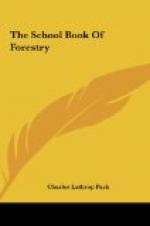The officers of the National Forests in the West have become very expert in running down the people who set incendiary fires. They collect evidence at the scene of the fire, such as pieces of letters and envelopes, matches, lost handkerchiefs and similar articles. They hunt for foot tracks and hoof marks. They study automobile tire tracks. They make plaster of Paris impressions of these tracks. They follow the tracks—sometimes Indian fashion. Often there are peculiarities about the tracks which lead to the detection and punishment of the culprits. A horse may be shod in an unusual manner; a man may have peculiar hob nails or rubber heels on his boots or else his footprints may show some deformity. The forest rangers play the parts of detectives very well. This novel police work has greatly reduced the number of incendiary fires.
[Illustration: Forest fires destroy millions of dollars worth of timber every year]
A forest fire may destroy in a few hours trees that required hundreds of years to grow. A heavy stand of timber may be reduced to a desolate waste because some one forgot to put out a campfire. Occasionally large forest fires burn farm buildings and homes and kill hundreds of people. During the dry summer season when a strong wind is blowing, the fire will run for many miles. It always leaves woe and desolation in its wake. A mammoth forest fire in Wisconsin many years ago burned over an area of two thousand square miles. It killed about fourteen hundred people and destroyed many millions of dollars worth of timber and other property. A big forest fire in Michigan laid waste a tract forty miles wide and one hundred and eighty miles long. More than four billion feet of lumber, worth $10,000,000, was destroyed and several hundred people lost their lives. In recent years, a destructive forest fire in Minnesota caused a loss of $25,000,000 worth of timber and property.
There are several different kinds of forest fires. Some burn unseen two to four feet beneath the surface of the ground. Where the soil contains much peat, these fires may persist for weeks or even months. Sometimes, they do not give off any noticeable smoke. Their fuel is the decaying wood, tree roots and similar material in the soil. These underground fires can be stopped only by flooding the area or by digging trenches down to the mineral soil. The most effectual way to fight light surface fires is to throw sand or earth on the flames. Where the fire has not made much headway, the flames can sometimes be beaten out with green branches, wet gunny sacks or blankets. The leaves and debris may be raked away in a path so as to impede their advance.




